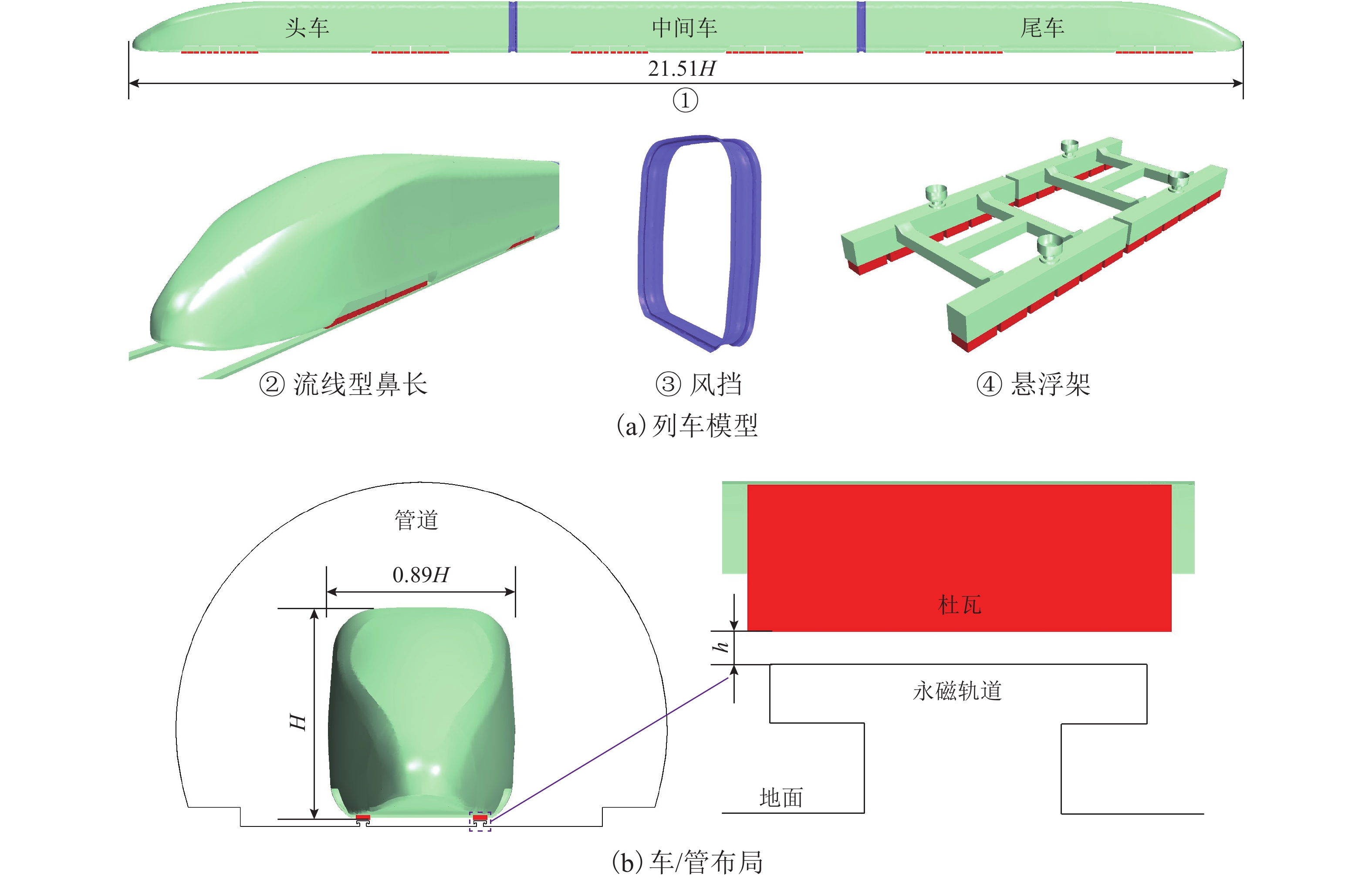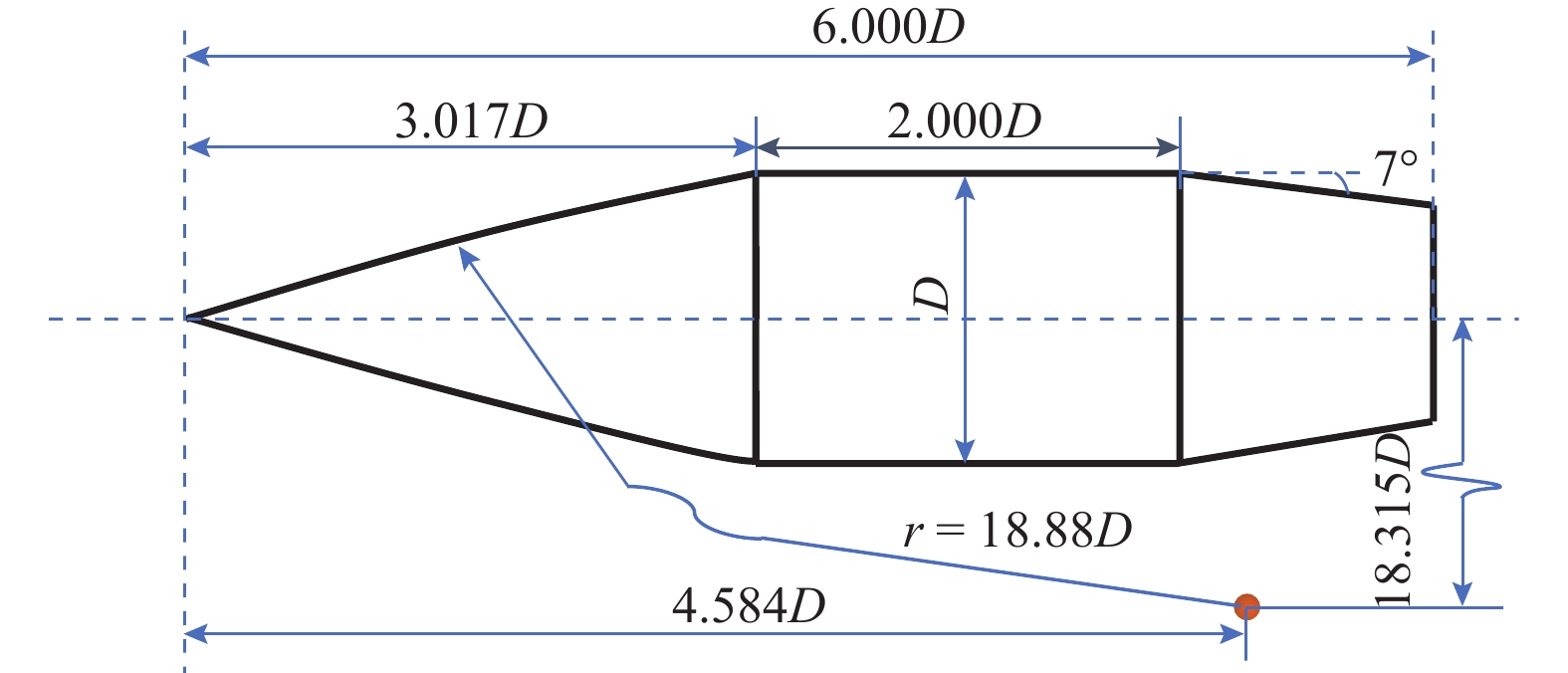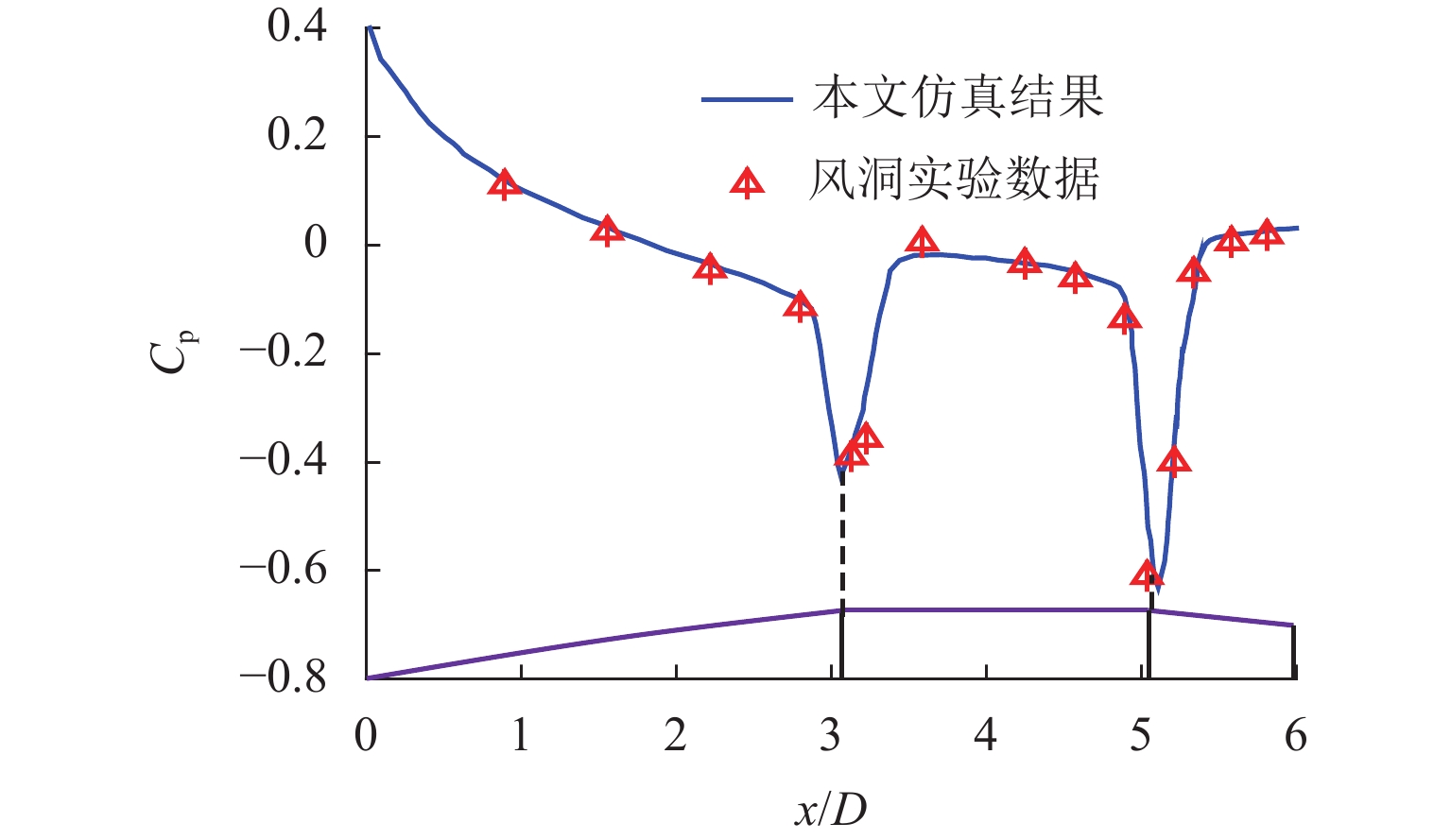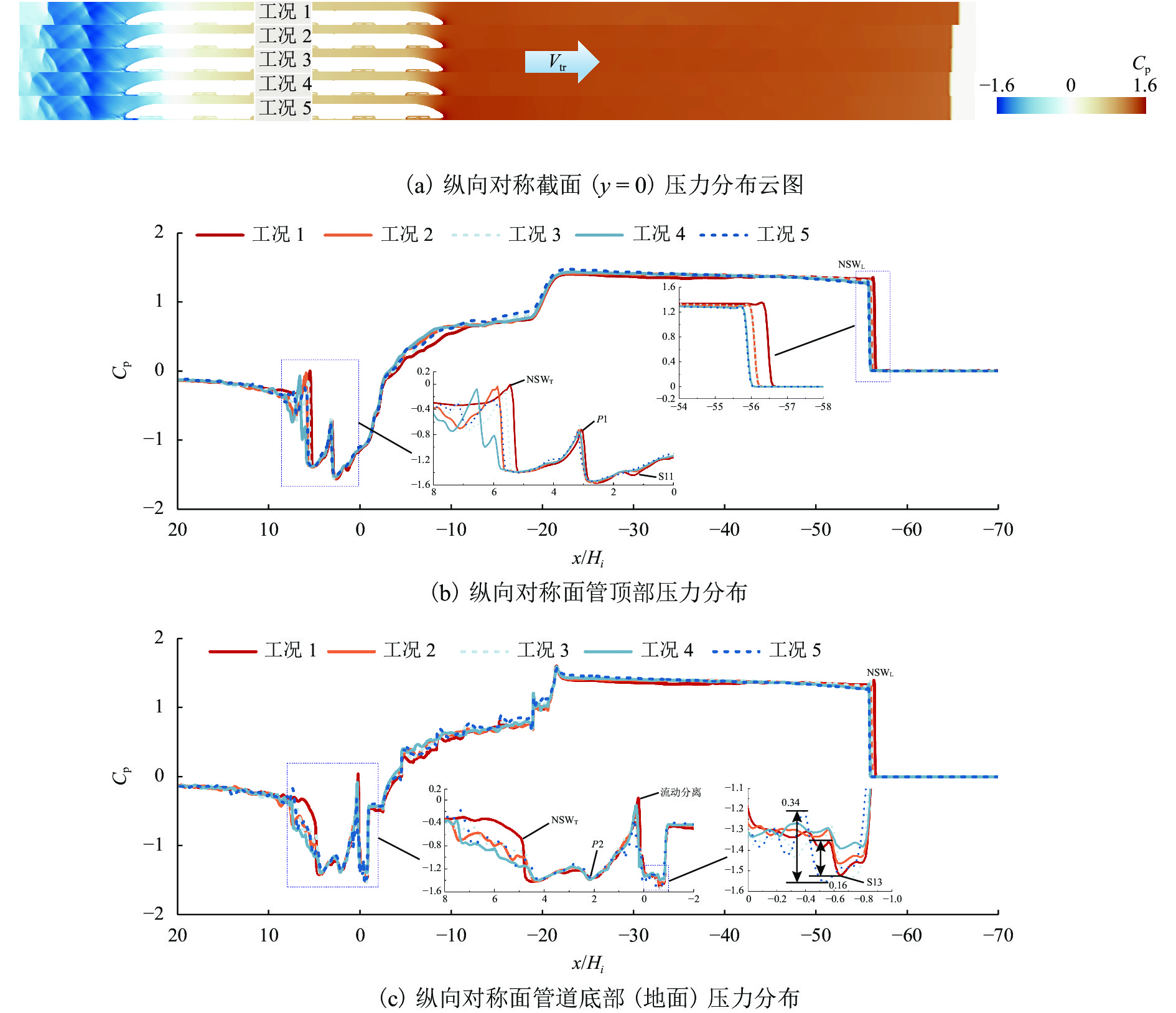Scale Effect of Aerodynamic Characteristics in Evacuated Tube Maglev Transport
-
摘要:
为了探究管道列车的尺度对波系、尾涡以及气动载荷的影响,基于CFD软件建立三种模型尺度(1∶1,1∶5和1∶10),同时考虑两种悬浮间隙关系(车轨相对间隙不变和绝对悬浮高度不变)的模型;采用改进的延迟分离涡模拟(IDDES)湍流模型和重叠网格技术模拟了列车在管道动态运动,并用风洞试验数据验证了数值方法和网格策略的合理性. 研究结果表明:列车尺度(雷诺数)增大,车前活塞区域变长,尾流扰动区范围缩短;雷诺数对近尾流区的涡对演化影响较小,但在远尾流区,随着列车尺度减小,涡对脉动变强,涡对强度的差异导致了车后正激波形态的差异;列车表面最大正压值和最大负压值均随着列车尺度增大而增大,悬浮间隙对最大正压值影响较小,但与最大负压值成正相关关系;尺度效应从压差阻力和摩擦阻力两方面共同影响气动阻力,整车摩擦阻力和头、中间车的压差阻力与雷诺数正相关,但是尾车压差阻力受附着激波的强度影响恰恰相反;列车尺度和悬浮高度均对升力影响较大. 相对于全尺寸模型,1∶10模型(悬浮高度20 mm)的最大正压值减小3.82%,最大负压值增大3.94%,整车总阻力增大8.64%,头车升力减小101.56%,尾车升力增大15.88%.
Abstract:In order to investigate the effect of the scale of a tube train on wave systems, wake vortices, and aerodynamic loads, three model scales (1∶1, 1∶5, and 1∶10) were established based on computational fluid dynamics(CFD) software, and two types of suspension gap relationships (constant relative gap between tracks and constant absolute suspension height) were considered. The improved delayed detached eddy simulation (IDDES) turbulence model and the overlapping mesh method were utilized to simulate the train’s dynamic motion in the tube, and wind tunnel test data were used to validate the numerical method and mesh strategy. The study results demonstrate that as the train scale (Reynolds number) increases, the front piston region lengthens, and the wake disturbance region shrinks in extent; Reynolds number has less effect on vortex pair evolution in the near wake region, but in the far wake region, vortex pair pulsation becomes stronger as the train scale decreases, and the difference in vortex pair strength leads to differences in the normal shock wave pattern in the rear of the train; the maximum positive and negative pressure values on the train surface increase as the scale of the train increases; the suspension gap has less influence on the maximum positive pressure value, but it is positively correlated with the maximum negative pressure value. The scale effect affects the aerodynamic drag from both pressure drag and friction drag. The friction drag of the whole train and the pressure drag of the head and middle trains are positively related to the Reynolds number; the pressure drag of the tail train, however, is influenced by the strength of the attached shock wave in an opposite way. Both train scale and suspension height significantly affect the lift. Compared with the full-scale model, the 1∶10 model (suspension height of 20 mm) has a 3.82% reduction in maximum positive pressure, a 3.94% increase in maximum negative pressure, an 8.64% increase in total drag, a 101.56% reduction in the lift of the head train, and a 15.88% increase in the lift of the tail train.
-
Key words:
- evacuated tube /
- overlapping mesh /
- scale effect /
- suspension height /
- aerodynamic characteristics
-
随着磁悬浮技术的飞速发展和人类追求更高速度交通工具的迫切需求,真空管道磁浮交通系统近些年来成为研究热点[1]. 与传统铁路运输和航空客运相比,真空管道磁浮交通系统(evacuated tube maglev transport)将地面交通与航空航天技术相结合,具有许多优势,包括节能、绿色以及外界环境干扰小等[2],高度契合当前“双碳”目标. 2021年12月,国家铁路局编制的《“十四五”铁路科技创新规划》中也明确提出“强化先进载运装备技术研发,开展低真空管(隧)高速列车等技术储备研发. ”
研究表明,虽然列车阻力随着管内气压的降低而减小[3-4],但与空气动力学相关的问题仍然存在,包括雍塞流[5]、波系相互作用[6]、气动热[7]等,这和传统列车通过隧道产生的气动现象有较大区别[8]. 相关专家学者基于数值计算开展了大量的低真空管道交通管内气动特性的基础研究:Zhou等[9-10]以某磁悬浮二维简化结构为研究对象,建立了二维轴对称模型,研究了跨音速下波系的发展过程和传播过程,并分析了不同波系对管道和列车壁面温度的影响趋势;Niu等[11]也建立了二维轴对称模型,利用滑移网格法研究了列车马赫数对管内热压耦合的影响,并进一步研究了列车加减速对管内流场的影响[12];为了研究狭小悬浮间隙的影响,张晓涵等[13]建立了二维非轴对称车/管模型,发现非对称模型的激波分布特征明显不同于对称模型.
为了进一步再现管内波系的三维空间分布特征,Hu等[14]建立了三维几何模型,基于重叠网格方法动态模拟列车运动,探讨了轨道对管内流动与传热的影响,研究表明列车尾流存在波系与尾涡的相互作用现象,使得流场更加复杂,这在二维模型中无法体现,并进一步研究了列车流线型长度对管内波系的影响,发现了两种边界层分离模式[15]. 此外,管内气流在雍塞和非雍塞状态下也存在着较大差异[16-17],雍塞状态下管内流场环境较为恶劣. 为了减缓此效应,从列车外形[18-19]和管道结构[20-21]两方面进行了优化设计.
近年来,随着对真空管道磁浮交通系统的日益关注,建成了一些相关测试平台:2014年6月,西南交通大学成功调试了真空管道高温超导磁悬浮列车试验系统“Super-Maglev”[22],初步开展了相关试验研究,受限于转弯半径,车辆最高试验速度为50 km/h;为了进一步提高试验速度,2020年西南交通大学开始建设最高时速可达1500公里的多态耦合轨道交通动模型试验平台;此外,2018年,青岛科技大学搭建成功环形真空管道浮交通系统试验台,研究了不同车速、环境压力下头尾车压差特性[23];2021年,中北大学与中国航天科工集团第三研究院联合建设真空管道电动磁浮列车试验线. 模型试验平台的搭建对推动我国超高速轨道交通技术引领、带动相关产业发展升级具有重大意义. 在模型实验中,流动相似性是必须要关心的问题. 在传统列车风洞试验和动模型试验中,通常保证试验雷诺数大于临界雷诺数,流动进入自模区,降低雷诺数效应[24]. 一些学者也对自模拟区的影响程度和列车的尺度效应进行了深入的研究[25-27]. 对于真空管道磁浮交通模型试验而言,由于列车速度达到亚音速或跨音速,不得不考虑气体压缩性的影响,即马赫数要保持一致. 其次磁浮列车的车轨间隙是电磁本质关系决定的,无法进行缩比,车轨之间相对间隙的改变也会对流场产生一定的影响[28].
鉴于此,本文以高温超导磁悬浮列车为研究对象,建立了3种不同的列车尺度(1∶1、1∶5和1∶10),同时考虑两种悬浮间隙:其一是保证车轨相对间隙不变,即悬浮高度随着列车尺度变化而变化,以此作为对照组;其二是保证车轨绝对悬浮高度不变,(具体的研究工况详见1.1节),从而探明雷诺数效应和地面效应(悬浮高度变化)耦合作用下管内流场的变化特性. 研究结果可为真空管道模型试验平台的建设提供参考,同时可为磁浮列车小尺度模型缩比试验外推到全尺寸时的数据修正提供理论依据.
1. 计算模型
1.1 列车/管道几何模型
如图1所示,本文采用的列车模型为3编组高温超导磁浮列车样车,包括头车、中间车和尾车. 各车厢之间采用风挡连接. 为了更真实模拟列车周围流场,列车气动模型保留了低温容器杜瓦和悬浮架等部件. 全尺寸下(1∶1)列车高度H为3.80 m,并把其作为特征尺寸. 列车总长为21.51H,最大车体宽度为0.89H,头尾车流线型长度为2.82H,列车最大横截面积Str=11.83 m2. 低真空管道截面形状参考高速铁路的隧道断面形状,车/管阻塞比为0.2639. 全尺寸模型的悬浮间隙h(磁悬浮列车车底(低温容器)和轨道之间的距离)为0.02 m.
本文计算工况具体参数详见表1,共模拟了3种列车尺度(1∶1、1∶5和1∶10),对应的雷诺数分别是7.240 × 105、1.448 × 105、0.724 × 105:其中工况1是全尺寸模型,作为基准组;工况2、4中,车轨布局方式完全缩比,悬浮高度随着尺度变化而变化,分析雷诺数对管内流场的影响;工况3、5保证绝对悬浮高度一致,是模型试验中实际的工况,分析雷诺数和地面效应耦合作用下管内流场变化特征.
表 1 计算工况参数Table 1. Parameters of calculation cases工况 缩尺
比例列车速度/
(km·h−1)雷诺
数/×105悬浮
高度/m1 1∶1 1000 7.240 0.020 2 1∶5 1000 1.448 0.004 3 1∶5 1000 1.448 0.020 4 1∶10 1000 0.724 0.002 5 1∶10 1000 0.724 0.020 1.2 计算区域和边界条件
本文采用重叠网格方法[13-15,29-30]动态模拟磁浮列车在真空管道内运行情况. 使用重叠网格不需要在生成初始网格之后进行任何网格修改和调整,在处理移动物体的研究时较为有效. 在本研究中,整个计算区域被划分成涵盖列车的重叠区域(移动区域)和包括整个管道空间的背景区域(静止区域),通过线性插值算法[31]对两个区域的流场信息进行匹配和耦合.
图2展示了全尺寸模型的计算区域尺寸及边界条件. 为了便于分析,将坐标系的原点固定在尾车流线型鼻端处. 磁浮列车在管道中前进方向对应x轴的负方向. 管道长度为210H. 在实际运行中,管道长度远远大于210H. 将管道两端边界设定为无反射的黎曼边界-自由流边界,避免压力波反射影响,从而模拟无限长管道[13-15]. 初始状态下,重叠区域在管道中的相对位置如图2所示,在x方向,重叠区域两端距管道左边界分别为20H和55H. 此外,重叠区域的宽度和高度分别为1.38H和1.39H. 管道、地面、轨道以及列车表面均设置为绝热无滑壁面边界条件. 管内气压大小和流动雷诺数密切相关,与本文研究的尺度效应类似,鉴于此,在初始时刻,本研究将管道内的静压固定为1013.25 Pa. 此工况已经被国内外学者广泛研究[14-15,17,19,32],较为典型,便于结果的比较. 同时静态环境温度设置为288 K,重叠区域的运动速度Vtr为1000 km/h.
2. 数值方法
2.1 物理模型和求解器
本文所有模拟均在多物理场商业软件Simcenter STAR-CCM+上运行. 由于列车在密闭管道中高速运行,必须考虑空气的可压缩性,因此采用三维、非定常、可压缩流动控制方程[14],空气密度ρ和动力黏度μ分别遵从理想气体定律和Sutherland定律.
使用改进的延迟分离涡模拟(IDDES)建模进行湍流求解,分离涡模拟(DES)是一种混合建模方法,使用雷诺平均(RANS)模型求解边界层和无旋流区域,其他区域采用大涡模拟(LES)求解. IDDES是DES模型的改进形式,为DES模型提供了壁面模化的LES(WMLES)能力,在一定程度上实现计算精度和计算时间的平衡,目前已被广泛用于高速列车气动特性研究中[33-34].
根据已有研究[15],管道内会生成较大流动分离现象,因此使用剪切输运(shear stress transport, SST)k-ω模型封闭方程组. SSTk-ω湍流模型中湍动能k和比耗散率ω的传输方程为
\begin{split} &\frac{\partial }{{\partial t}}(\rho k) + \nabla \cdot (\rho k{\boldsymbol{V}}) = \nabla \cdot\left[ {\left( {\mu + {\sigma _k}{\mu _{\rm{t}}}} \right)\nabla k} \right] + \\&\quad {P_k} - \rho {\beta ^ * }{f_{{\beta ^ * }}}\left( {\omega k - {\omega _0}{k_0}} \right) + {S_k} \text{,} \\ \end{split} (1) \begin{split} &\frac{\partial }{{\partial t}}(\rho \omega ) +\nabla \cdot (\rho \omega {\boldsymbol{V}}) = \nabla \cdot \left[ {\left( {\mu + {\sigma _\omega }{\mu _{\rm{t}}}} \right)\nabla \omega } \right] + \\& \quad {P_\omega } - \rho \beta {f_\beta }\left( {{\omega ^2} - \omega _0^2} \right) + {S_\omega }\text{,} \\ \end{split} (2) 式中:{\boldsymbol{V}}和\; {\mu _{\rm{t}}} 分别为流体速度和湍流涡黏度; {\sigma _k} 、 {\sigma _\omega } 、 \beta 、 {\beta ^ * } 均为模型系数; {P_k} 、 {P_\omega } 分别为湍动能和比耗散率的产生项; {f_\beta } 为涡流延伸修正因子; {f_{{\beta ^ * }}} 为自由剪切修正因子; {S_k} 和 {S_\omega } 为源项; {\omega _0} 、 {k_0} 为环境湍流值;t为时间.
在IDDES湍流模型中,将式(1)中的比耗散率 \omega 替换为 \tilde \omega ,\tilde \omega 为
\tilde \omega = \frac{{\sqrt k }}{{{l_{{\text{IDDES}}}}{\beta ^ * }{f_{{\beta ^ * }}}}} \text{,} (3) 式中: {l_{{\text{IDDES}}}} 为IDDES中混合长度尺度.
为增强WMLES能力,引入混合函数 {\tilde f_{\rm{d}}} 和提升函数 {f_{\rm{e}}} ,如式(4).
{l_{{\text{IDDES}}}} = {\tilde f_{\rm{d}}}\left( {1 + {f_{\rm{e}}}} \right){l_{{\rm{RANS}}}} + \left( {1 - {{\tilde f}_{\rm{d}}}} \right){l_{{\rm{LES}}}} \text{,} (4) 式中:{l_{{\rm{RANS}}}} = {{\sqrt k }}/({{{\beta ^ * }\omega }});{l_{{\rm{LES}}}} = {C_{{\text{DES}}}}{{{\varDelta }}_{{\text{IDDES}}}},{C_{{\text{DES}}}} = 0.78{F_1} + 0.61\left( {1 - {F_1}} \right),
\begin{split} & {F_1} = \tanh \left( \left[ \min \left\{ \max \left\{ {\frac{{\sqrt k }}{{0.09\omega d}},\frac{{500v}}{{{d^2}\omega }}} \right\},\right.\right.\right.\\ & \quad \left.\left.\left. {{2k}}/\left({{{d^2}\max \left\{ {\dfrac{1}{\omega }\nabla k \cdot \nabla \omega ,{{10}^{ - 20}}} \right\}}}\right) \right\} \right]^4 \right) \text{,} \end{split} D为网格到壁面的距离, v 为运动黏度;
{{{\varDelta }}_{{\text{IDDES}}}} = \min \left\{ {\max \left\{ {0.15d,0.15{{{\varDelta }}_{{\text{max}}}},{{{\varDelta }}_{{\rm{wn}}}}} \right\},{{{\varDelta }}_{{\text{max}}}}} \right\} \text{,} {{{\varDelta }}_{{\text{max}}}}为相邻网格最大间距,{{{\varDelta }}_{{\rm{wn}}}}为壁面法线方向的网格步长.
在空间上,基于有限体积法离散控制方程,通过耦合流求解器求解离散的代数方程组. 采用混合二阶迎风/有界中心差分格式离散对流项,混合因子为0.15,即允许15%的二阶迎风和85%的有界中心差分格式. 选择AUSM+格式处理对流通量,可以准确捕捉激波不连续性[9-10]. 时间项采用二阶精度隐式格式,时间步长为0.013Tref (Tref =Hi/Vtr,Hi为不同工况i的列车车高,既保证最大库朗数不超过1.0,也满足重叠网格方法对时间步长的要求[31]. 在每个时间步内,最大内迭代次数为20,列车在管道内运行的物理总时长为73.1Tref.
2.2 网格策略
网格策略参考作者前期研究,并对网格尺寸进行了独立性验证[14-15]. 本文采用非结构化的混合网格对计算域进行网格剖分. 对于主体区域,利用切割体网格生成器划分网格,并对流动复杂区域,例如尾流区域和列车底部进行多级网格加密,如图3所示,列车周围最小网格尺寸为0.013H. 为了捕捉壁面流动,对列车表面划分22层棱柱层网格,拉伸比为1.2,近壁面边界层网格厚度为5.26 × 10−5H. 本文计算5种工况的网格数目均在2200万左右.
2.3 数据无量纲化
为了便于计算结果的比较,对相关数据进行了无量纲化处理,如式(5).
\left\{ \begin{array}{l} {C_{\rm{p}}} = (p - {p_0})\bigg/\left(\dfrac{1}{2}\rho V_{{\rm{tr}}}^2 \right)\text{,}\\ {C_{\rm{d}}} = {F_{\rm{d}}}\bigg/\left(\dfrac{1}{2}\rho V_{{\rm{tr}}}^2{S_{{\rm{tr}}}} \right)\text{,}\\ {C_{\rm{l}}} = {F_{\rm{l}}}\bigg/\left(\dfrac{1}{2}\rho V_{{\rm{tr}}}^2{S_{{\rm{tr}}}}\right)\text{,}\\ {C_{\rm{T}}} = (T - {T_0})/{T_0}\text{,}\\ {Q^*} = QT_{{\rm{ref}}}^2 = \dfrac{1}{2}\left( {{{\boldsymbol{\varOmega}} ^2} - {{\boldsymbol{S}}^2}} \right)\dfrac{{{H_i}^2}}{{V_{{\rm{tr}}}^2}} {,}\\ {\omega ^*} = \omega {T_{{\rm{ref}}}} = \omega \dfrac{{{H_i}}}{{{V_{{\rm{tr}}}}}}\text{,} \end{array} \right. (5) 式中: {C_{\rm{p}}} 为压力系数; {C_{\rm{d}}} 为阻力系数; {C_{\rm{l}}} 为升力系数; {C_{\rm{T}}} 为温度系数; {Q^ * } 为无量纲化的Q准则; {\omega ^ * } 为无量纲涡度;p、p0分别为表面静压、参考压力;T、T0分别为温度、初始温度;Fd、Fl分别为气动阻力和气动升力;在0.01个大气压下,空气密度 \rho =1.225 × 10−2 kg/m3;S、Ω分别为速度变量的应变率张量和旋转率张量.
2.4 数值方法验证
目前,关于低真空管道磁浮列车系统的高速气动试验尚未有公开的数据,本节以切割弹头-圆筒弹身-船形弹尾组成的细长弹丸(SOCBT弹丸)作为数值计算方法的验证对象,模型几何尺寸如图4所示,其中弹丸直径D为57 mm,攻角为0°,并与Kayser和Whiton[35]在兰利研究中心的跨音速风洞测试的试验数据进行比较. 跨音速风洞测试的马赫数为0.91,与本文模拟的列车运动速度接近. 数值方法和网格策略参照2.1节和2.2节.
图5为SOCBT弹丸表面压力系数分布,从图中看出,数值模拟结果与风洞实验数据吻合良好,证明了本文采用的数值方法具有较高的准确性,可以用来模拟跨音速磁浮列车的气动效应.
3. 结果与讨论
3.1 管内流场基本特征
本节以全尺寸1∶1模型(工况1)的结果为例分析管内流场基本特征. 图6和图7分别展示了列车前方和尾流区域管内温度分布. 如图6所示,正激波NSWL将列车前方空间分成活塞区域和未扰动区域[9-15]. 显然,未扰动区域的流动物理量与管道初始状态的物理量一致. 活塞区域是一个高压高温区域,活塞区域的长度取决于正激波NSWL和列车运动速度差.
相比于列车前方,列车尾流区域的流动非常复杂. 列车与管道之间形成了一种拉瓦尔喷管模式,尾车流线型区域对应喷管的扩张段,此处出现经典的Prandtl Meyer等熵流,气流加速,温度下降,出现较大区域的低温区域. 由于过度膨胀,喷管出口即尾车鼻尖附近的温度(压力)小于管内初始环境温度(压力),在管内空间形成斜激波S1. 从横截面x=0.5H的等温线分布可以看出,在三维空间上,斜激波S1是个弧形斜激波,映射到二维截面上,在尾车顶部、侧面和底部形成的激波分别定义为S11、S12和S13. 随着激波S1进一步在尾流区域传播,在管道两侧反射形成反射激波S2和S3,在管道顶部反射形成反射激波S4. 反射激波S2和S3在传播过程中相互相交,在纵向对称平面上形成相交线L1[16],在管道上、下壁面分别相交在P1点和P2点. 此外,反射激波S4在传播过程也与激波S2和S3相交在P3点,造成了局部低温区. 在斜激波和膨胀波反射终止处形成一个正激波NSWT,用来恢复尾流区温度(压力)至管内初始状态.
此外,通过温度云图观察到列车尾流还存在一对反向旋转的涡,并且涡对沿着轨道螺旋上升,激波与涡对的相互作用增加了尾流的复杂程度.
3.2 尺度效应(雷诺数效应)对管内波系的影响
1) 图8比较了不同尺度下管道上、下壁面压力分布. 列车尺度对管道上壁面压力的空间分布规律影响不大,但是对车前、车后的正激波位置有影响. 在保证车轨相对间隙一致的情况下,即悬浮高度也随着列车尺度变化而变化,对应工况1、2、4,列车尺度(雷诺数)增大,车前活塞区域变长,尾流扰动区的范围缩短. 可见,增大列车雷诺数可以延缓尾流波系的发展过程,但加快了正激波NSWL的形成. 此外,在同一个雷诺数下,悬浮高度对车前正激波的位置和强度几乎无影响,但对尾流正激波的位置有影响,提高悬浮高度,尾流扰动区的范围缩短,延缓了尾流波系的发展过程. 2) 此外,与管道上壁面相比,由于地面效应以及尾涡的影响,管道底部(地面)物理量的变化更加复杂,波动更剧烈. 同时,由图8(b)可见,不同雷诺数和悬浮高度下,地面压力波动差异主要存在车后正激波NSWT和尾车鼻尖处. 列车尺度(雷诺数)增大,尾车底部斜激波S13的强度增强,造成激波边界层干扰更剧烈,使得波后边界层内分离加强,造成压差阻力增大,压差阻力具体分析见3.3节. 同时悬浮高度的增加也会显著增强激波S13的强度,工况5中S13的强度是工况1的2.125倍.
另外,不同尺度下地面的NSWT强度也存在着较大差异. 为了探究其背后流动机制,图9通过无量纲Q准则( {Q^ * } =1)的等值面可视化尾涡结构,并用无量纲涡度 {\omega ^ * } 着色等值面,用来度量涡流运动能力. 从图9可以看出:尾车流线型处脱落一对反向旋转的涡(V1和V2),涡对沿着轨道螺旋上升,并且涡对发展经历了两个阶段,分别对应近尾流区和远尾流区域,尾流正激波NSWT是两个区域分界面;在近尾流区,涡团以大涡为主,湍流脉动较小,管内波系传播占主导地位,雷诺数对近尾流区的涡对演化影响较小;在远尾流区,无波系传播,涡对充分发展,随着列车尺度(雷诺数)减小,黏性效应增强,远尾流区的小涡增多,脉动增强,同时悬浮间隙的增大进一步加剧了涡团脉动和非定常特性. 因此不同雷诺数下涡团与尾流正激波NSWT相对作用时存在显著差异,工况1中涡团脉动较小,对正激波的强度影响较小,而其他工况下涡团耗散了正激波的大部分能量,从云图和地面压力分布看不出正激波形态.
3.3 尺度效应(雷诺数效应)对气动载荷的影响
图10比较了列车上表面和底部的表面压力波动. 列车表面最大正压Cp-max和最大负压Cp-min分别出现在头车鼻尖和尾车底部第一个悬浮架附近. 1) 从图10(a)看出,列车表面最大正压值随着尺度(雷诺数)增大而增大,但是车轨之间相对间隙对其影响较小. 当悬浮高度h不变(h=20 mm),列车尺度从1∶1 (工况1)缩尺至1∶10 (工况5)时,Cp-max减小3.82%. 2) 同时根据图10(b),在保证车轨相对间隙一致的情况下,即悬浮高度也随着列车尺度变化而变化,列车表面最大负压值也随着尺度(雷诺数)增大而增大,列车尺度从1∶1 (工况1)缩尺至1∶10 (工况4)时,Cp-min减小5.17%,而悬浮间隙的增加加剧了列车底部流动,在同一个列车尺度下,当悬浮高度由2 mm (工况4)增大到20 mm (工况5)时,Cp-min增大9.6%. 在尺度效应和地面效应(悬浮高度变化)耦合效应下,相对于工况1,工况5的Cp-min增大3.94%. 3) 同时,列车上表面压力分布在−11.86 < x/Hi < −3.00也存在较大差异,这主要是雷诺数效应造成的. 列车尺度(雷诺数)增大,黏性效应减小,边界层变薄[26-27]. 而列车在头车区域的边界层厚度相对较小,沿流动方向列车表面边界层厚度逐渐增加,气流经过尾车流线型部位时,由于膨胀加速,边界层变薄. 因此在不同尺度下列车上表面压力分布差异较大的区域对应着边界层充分发展的区域.
根据列车表面的Cp分布,计算得到平均阻力系数Cd和升力系数Cl,分别在表2和表3中列出,表中各车厢力系数不包括风挡部分.
表 2 不同尺度下列车平均阻力系数Table 2. Average drag coefficient of trains with different scales工况 头车 中间车 尾车 整车 压差
阻力摩擦
阻力总阻力 压差
阻力摩擦
阻力总阻力 压差
阻力摩擦
阻力总阻力 压差
阻力摩擦
阻力总阻力 1 1.2144 0.0622 1.2766 0.0132 0.0537 0.0669 1.1826 0.0815 1.2641 2.4359 0.1980 2.6339 2 1.2309 0.0795 1.3104 0.0147 0.0706 0.0854 1.1615 0.1119 1.2734 2.4198 0.2629 2.6827 3 1.2591 0.0799 1.3390 0.0225 0.0728 0.0953 1.1795 0.1139 1.2934 2.4746 0.2665 2.7412 4 1.2363 0.0863 1.3226 0.0163 0.0808 0.0970 1.1519 0.1313 1.2832 2.4144 0.2993 2.7137 5 1.2854 0.0865 1.3719 0.0400 0.0860 0.1260 1.2149 0.1357 1.3506 2.5522 0.3093 2.8615 表 3 不同尺度下列车平均升力系数Table 3. Average lift coefficient of trains with different scales工况 头车 中间车 尾车 整车 1 0.1156 −0.0029 0.3368 0.4363 2 0.0534 −0.0190 0.3659 0.3920 3 0.0171 −0.0252 0.3754 0.3562 4 0.0491 −0.0167 0.3688 0.3883 5 −0.0018 −0.0424 0.3903 0.3368 由表2可见,压差阻力占据主导地位,约为总阻力的90.0%. 这是由于管道内产生的激波导致车头和车尾的压差很大,形成激波阻力,本质上也是一种压差阻力[20].
2) 在保证车轨相对间隙一致的情况下,即悬浮高度也随着列车尺度变化而变化,对应工况1、2、4,雷诺数效应从压差阻力和摩擦阻力两方面共同影响列车气动阻力. 列车尺度(雷诺数)减小,黏性效应增强,各车厢的摩擦阻力增大,列车尺度缩小10倍(工况1~4)时,头车、中间车以及尾车的摩擦阻力分别增大38.75%、50.47%、61.10%;同时由于列车尺度(雷诺数)减小,边界层变厚,造成管道有效净空面积减少,加剧了管道内流动,增加了头车和中间车的压差阻力,但是尾车变化规律相反,因为雷诺数与激波强度正相关,工况1中激波诱导附面层分离的增强,造成了尾车压差阻力增大. 因而,在不同尺度整车压差阻力系数的变化不明显,与工况1相比,工况4整车压差阻力减小0.88%.
3) 悬浮间隙对列车气动阻力也有较大影响,特别是尾车压差阻力. 在同一个尺度下,增加悬浮间隙,列车底部气流上洗增强,与列车顶部和侧墙下洗气流相互作用加大,扩大了两种气流的混合范围[33],增大了压差阻力. 在尺度效应和地面效应(悬浮高度变化)耦合效应下,与工况1相比,工况5的整车摩擦阻力增大56.21%,压差阻力增大4.78%,总阻力增大8.64%.
由表3可见,尾车升力占据主导地位,对整车的贡献超过了75%,其次是头车,中间车的升力最小. 从列车上、下表面载荷分布不难看出,由于流动分离、悬浮架腔等导致尾车上、下表面压力载荷分布差异较大,从而形成了较大的升力.
在车轨相对间隙一致的情况下,头车和中间车升力随着列车尺度(雷诺数)增大而增大,尾车则呈现减小趋势,这主要是由于列车尺度增大,尾车激波与边界层干扰剧烈,造成更大的流动分离,从而产生较小的升力,这种现象称为激波失速.
同时保证列车尺度相同,悬浮高度变化对列车升力影响也较为明显. 悬浮高度增大,头车升力减小,中间车和尾车升力增大,和文献[28, 32]结论一致. 这主要是因为悬浮高度变化对列车底部气流流向发展的影响程度存在差异[28].
定量分析来说,保持相对悬浮高度不变,列车尺度缩小10倍(工况1~4),头车升力减小57.53%,尾车升力增大9.50%;保持列车尺度不变,绝对悬浮高度从2 mm增加20 mm(工况4~5),头车升力减小103.67%,尾车升力增大5.83%;在尺度效应和地面效应(悬浮高度变化)耦合效应下,与工况1相比,工况5的头车升力减小101.56%,尾车升力增大15.88%. 由于中间车升力数值较小,本文并未展示其变化程度.
4. 结 论
本文从管内波系传播、尾涡演化特性、气动载荷分布3方面研究真空管道磁浮交通气动特性的尺度效应,主要得出以下结论:
1) 列车尺度(雷诺数)增大,车前活塞区域变长,尾流扰动区的范围缩短. 此外,在同一个雷诺数下,悬浮高度对车前正激波的位置和强度几乎无影响,但是对车后正激波的位置有影响,提高悬浮高度,尾流扰动区的范围缩短,延缓了尾流波系的发展过程.
2) 尾涡演化经历了近尾流区和远尾流区域两个阶段,车后正激波是区域分界面. 在近尾流区,管内波系传播占主导地位,雷诺数对近尾流区的涡对演化影响较小;在远尾流区,雷诺数对其影响较大,随着列车尺度(雷诺数)减小,涡对脉动变强,同时悬浮间隙的提高进一步加剧了非定常特性. 涡对强度的差异导致了车后正激波形态的差异.
3) 列车表面最大正压值和最大负压值均随着雷诺数增大而增大;悬浮间隙对最大正压值影响较小,但与最大负压值成正相关关系,在尺度效应和地面效应(悬浮高度变化)耦合效应下,相对于全尺寸,1∶10模型(悬浮高度20 mm)的最大正压值减小3.82%. 最大负压值增大3.94%. 同时由于雷诺数效应,不同尺度下边界层充分发展的区域压力分布差异也较大.
4) 雷诺数效应从压差阻力和摩擦阻力两方面共同影响列车气动阻力. 列车尺度减小,摩擦阻力增大,列车尺度缩小10倍时,头车、中间车以及尾车的摩擦阻力分别增大38.75%、50.47%、61.10%;同时由于列车尺度减小,边界层变厚,加剧了管道内流动,增加了头车和中间车的压差阻力,但是尾车变化规律相反,尾车的压差阻力主要取决于附着激波的强度.
5) 受到流动分离等影响,尾车升力对整车贡献高达75%以上. 头车升力随着列车尺度增大而增大,尾车升力相反. 同时悬浮高度变化对列车升力影响也较为明显. 相对于全尺寸,1∶10模型(悬浮高度20 mm)的头车升力减小101.56%,尾车升力增大15.88%.
本文研究了运行速度1000 km/h时尺度效应对管道气动特性的影响,下一步研究中,将系统性地研究多个速度域(亚音速、跨音速和超音速)下尺度效应,服务真空管道交通模型试验平台的建设.
致谢:中铁第四勘察设计院集团有限公司高温超导磁浮低真空管道工艺研究(2019K118)项目.
-
表 1 计算工况参数
Table 1. Parameters of calculation cases
工况 缩尺
比例列车速度/
(km·h−1)雷诺
数/×105悬浮
高度/m1 1∶1 1000 7.240 0.020 2 1∶5 1000 1.448 0.004 3 1∶5 1000 1.448 0.020 4 1∶10 1000 0.724 0.002 5 1∶10 1000 0.724 0.020 表 2 不同尺度下列车平均阻力系数
Table 2. Average drag coefficient of trains with different scales
工况 头车 中间车 尾车 整车 压差
阻力摩擦
阻力总阻力 压差
阻力摩擦
阻力总阻力 压差
阻力摩擦
阻力总阻力 压差
阻力摩擦
阻力总阻力 1 1.2144 0.0622 1.2766 0.0132 0.0537 0.0669 1.1826 0.0815 1.2641 2.4359 0.1980 2.6339 2 1.2309 0.0795 1.3104 0.0147 0.0706 0.0854 1.1615 0.1119 1.2734 2.4198 0.2629 2.6827 3 1.2591 0.0799 1.3390 0.0225 0.0728 0.0953 1.1795 0.1139 1.2934 2.4746 0.2665 2.7412 4 1.2363 0.0863 1.3226 0.0163 0.0808 0.0970 1.1519 0.1313 1.2832 2.4144 0.2993 2.7137 5 1.2854 0.0865 1.3719 0.0400 0.0860 0.1260 1.2149 0.1357 1.3506 2.5522 0.3093 2.8615 表 3 不同尺度下列车平均升力系数
Table 3. Average lift coefficient of trains with different scales
工况 头车 中间车 尾车 整车 1 0.1156 −0.0029 0.3368 0.4363 2 0.0534 −0.0190 0.3659 0.3920 3 0.0171 −0.0252 0.3754 0.3562 4 0.0491 −0.0167 0.3688 0.3883 5 −0.0018 −0.0424 0.3903 0.3368 -
[1] 邓自刚,张勇,王博,等. 真空管道运输系统发展现状及展望[J]. 西南交通大学学报,2019,54(5): 1063-1072.DENG Zigang, ZHANG Yong, WANG Bo, et al. Present situation and prospect of evacuated tube transportation system[J]. Journal of Southwest Jiaotong University, 2019, 54(5): 1063-1072. [2] VAN GOEVERDEN K, MILAKIS D, JANIC M, et al. Analysis and modelling of performances of the HL (Hyperloop) transport system[J]. European Transport Research Review, 2018, 10(2): 1-17. [3] MA T H, HU X, WANG J K, et al. Effect of air pressure on aerodynamic characteristics of the HTS maglev running in a tube[J]. IEEE Transactions on Applied Superconductivity, 2021, 31(8): 0501004.1-0501004.4. [4] SUI Y, NIU J Q, RICCO P, et al. Impact of vacuum degree on the aerodynamics of a high-speed train capsule running in a tube[J]. International Journal of Heat and Fluid Flow, 2021, 88: 108752.1-108752.14. [5] KANG H, JIN Y M, KWON H, et al. A study on the aerodynamic drag of transonic vehicle in evacuated tube using computational fluid dynamics[J]. International Journal of Aeronautical and Space Sciences, 2017, 18(4): 614-622. doi: 10.5139/IJASS.2017.18.4.614 [6] 周鹏,李田,张继业,等. 真空管道超级列车激波簇结构研究[J]. 机械工程学报,2020,56(2): 86-97. doi: 10.3901/JME.2020.02.086ZHOU Peng, LI Tian, ZHANG Jiye, et al. Research on shock wave trains generated by the hyper train in the evacuated tube[J]. Journal of Mechanical Engineering, 2020, 56(2): 86-97. doi: 10.3901/JME.2020.02.086 [7] BAO S J, HU X, WANG J K, et al. Numerical study on the influence of initial ambient temperature on the aerodynamic heating in the tube train system[J]. Advances in Aerodynamics, 2020, 2: 28.1-28.18. [8] 梅元贵, 周朝晖, 许建林. 高速铁路隧道空气动力学[M]. 北京: 科学出版社, 2009. [9] ZHOU P, ZHANG J Y, LI T, et al. Numerical study on wave phenomena produced by the super high-speed evacuated tube maglev train[J]. Journal of Wind Engineering and Industrial Aerodynamics, 2019, 190: 61-70. doi: 10.1016/j.jweia.2019.04.003 [10] ZHOU P, ZHANG J Y. Aerothermal mechanisms induced by the super high-speed evacuated tube maglev train[J]. Vacuum, 2020, 173: 109142.1-109142.9. [11] NIU J Q, SUI Y, YU Q J, et al. Numerical study on the impact of Mach number on the coupling effect of aerodynamic heating and aerodynamic pressure caused by a tube train[J]. Journal of Wind Engineering and Industrial Aerodynamics, 2019, 190: 100-111. doi: 10.1016/j.jweia.2019.04.001 [12] NIU J Q, SUI Y, YU Q J, et al. Effect of acceleration and deceleration of a capsule train running at transonic speed on the flow and heat transfer in the tube[J]. Aerospace Science and Technology, 2020, 105: 105977.1-105977.12. [13] 张晓涵,李田,张继业,等. 亚音速真空管道列车气动壅塞及激波现象[J]. 机械工程学报,2021,57(4): 182-190. doi: 10.3901/JME.2021.04.182ZHANG Xiaohan, LI Tian, ZHANG Jiye, et al. Aerodynamic choked flow and shock wave phenomena of subsonic evacuated tube train[J]. Journal of Mechanical Engineering, 2021, 57(4): 182-190. doi: 10.3901/JME.2021.04.182 [14] HU X, DENG Z G, ZHANG J W, et al. Effect of tracks on the flow and heat transfer of supersonic evacuated tube maglev transportation[J]. Journal of Fluids and Structures, 2021, 107: 103413.1-103413.16. [15] HU X, DENG Z G, ZHANG J W, et al. Aerodynamic behaviors in supersonic evacuated tube transportation with different train nose lengths[J]. International Journal of Heat and Mass Transfer, 2022, 183: 122130.1-122130.13. [16] ZHONG S, QIAN B S, YANG M Z, et al. Investigation on flow field structure and aerodynamic load in vacuum tube transportation system[J]. Journal of Wind Engineering and Industrial Aerodynamics, 2021, 215: 104681.1-104681.14. [17] YU Q J, YANG X F, NIU J Q, et al. Aerodynamic thermal environment around transonic tube train in choked/unchoked flow[J]. International Journal of Heat and Fluid Flow, 2021, 92: 108890.1-108890.15. [18] BIZZOZERO M, SATO Y, SAYED M A. Aerodynamic study of a Hyperloop pod equipped with compressor to overcome the Kantrowitz limit[J]. Journal of Wind Engineering and Industrial Aerodynamics, 2021, 218: 104784.1-104784.16. [19] ZHOU K Y, DING G F, WANG Y M, et al. Aeroheating and aerodynamic performance of a transonic hyperloop pod with radial gap and axial channel: a contrastive study[J]. Journal of Wind Engineering and Industrial Aerodynamics, 2021, 212: 104591.1-104591.16. [20] HU X, DENG Z G, ZHANG W H. Effect of cross passage on aerodynamic characteristics of super-high-speed evacuated tube transportation[J]. Journal of Wind Engineering and Industrial Aerodynamics, 2021, 211: 104562.1-104562.15. [21] JIA W G, WANG K, CHENG A P, et al. Air flow and differential pressure characteristics in the vacuum tube transportation system based on pressure recycle ducts[J]. Vacuum, 2018, 150: 58-68. doi: 10.1016/j.vacuum.2017.12.023 [22] DENG Z G, ZHANG W H, ZHENG J, et al. A high-temperature superconducting maglev-evacuated tube transport (HTS maglev-ETT) test system[J]. IEEE Transactions on Applied Superconductivity, 2017, 27(6): 3602008.1-3602008.8. [23] 刘英杰. 真空管道高速交通系统气动特性试验装置的研制[D]. 青岛: 青岛科技大学, 2015. [24] 田红旗. 列车空气动力学[M]. 北京: 中国铁道出版社, 2007. [25] 韩运动,姚松. 高速列车气动性能的尺度效应分析[J]. 浙江大学学报(工学版),2017,51(12): 2383-2391. doi: 10.3785/j.issn.1008-973X.2017.12.010HAN Yundong, YAO Song. Scale effect analysis in aerodynamic performance of high-speed train[J]. Journal of Zhejiang University (Engineering Science), 2017, 51(12): 2383-2391. doi: 10.3785/j.issn.1008-973X.2017.12.010 [26] NIU J Q, ZHOU D, LIANG X F, et al. Numerical simulation of the Reynolds number effect on the aerodynamic pressure in tunnels[J]. Journal of Wind Engineering and Industrial Aerodynamics, 2018, 173: 187-198. doi: 10.1016/j.jweia.2017.12.013 [27] TSCHEPE J, NAYERI C N, PASCHEREIT C O. On the influence of Reynolds number and ground conditions on the scaling of the aerodynamic drag of trains[J]. Journal of Wind Engineering and Industrial Aerodynamics, 2021, 213: 104594.1-104594.22. [28] 孟石,周丹,孟爽. 轨道间隙对磁浮列车气动性能的影响[J]. 中南大学学报(自然科学版),2020,51(12): 3537-3545.MENG Shi, ZHOU Dan, MENG Shuang. Effect of rail gap on aerodynamic performance of maglev train[J]. Journal of Central South University (Science and Technology), 2020, 51(12): 3537-3545. [29] 胡啸,孔繁冰,梁永廷,等. 线间距对高速列车隧道内交会压力波影响的数值模拟研究[J]. 振动与冲击,2020,39(21): 79-88.HU Xiao, KONG Fanbing, LIANG Yongting, et al. Numerical simulation for influence of line spacing on crossing pressure wave of high-speed trains in tunnel[J]. Journal of Vibration and Shock, 2020, 39(21): 79-88. [30] 胡啸,余以正,陈然,等. 隧道内高速列车交会时车体两侧压差波动特性数值模拟研究[J]. 铁道机车车辆,2019,39(3): 124-130.HU Xiao, YU Yizheng, CHEN Ran, et al. Numerical simulation study on pressure difference fluctuation on both sides of car when high-speed trains crossing in tunnel[J]. Railway Locomotive & Car, 2019, 39(3): 124-130. [31] 王慕之,梅元贵,贾永兴. 重叠网格法应用于模拟高速列车隧道气动效应[J]. 应用力学学报,2017,34(3): 589-595.WANG Muzhi, MEI Yuangui, JIA Yongxing. Simulation of aerodynamic effects generated by a high-speed train passing through a tunnel with overset grid method[J]. Chinese Journal of Applied Mechanics, 2017, 34(3): 589-595. [32] ZHOU P, QIN D, ZHANG J Y, et al. Aerodynamic characteristics of the evacuated tube maglev train considering the suspension gap[J]. International Journal of Rail Transportation, 2022, 10(2): 195-215. doi: 10.1080/23248378.2021.1885514 [33] DONG T Y, MINELLI G, WANG J B, et al. The effect of ground clearance on the aerodynamics of a generic high-speed train[J]. Journal of Fluids and Structures, 2020, 95: 102990.1-102990.20. [34] WANG S B, BURTON D, HERBST A H, et al. The effect of the ground condition on high-speed train slipstream[J]. Journal of Wind Engineering and Industrial Aerodynamics, 2018, 172: 230-243. doi: 10.1016/j.jweia.2017.11.009 [35] KAYSER L, WHITON F. Surface pressure measurements on a boattailed projectile shape at transonic speeds[R]. Maryland: Army Ballistic Research Laboratory, 1982. -






 下载:
下载:










 下载:
下载:




















